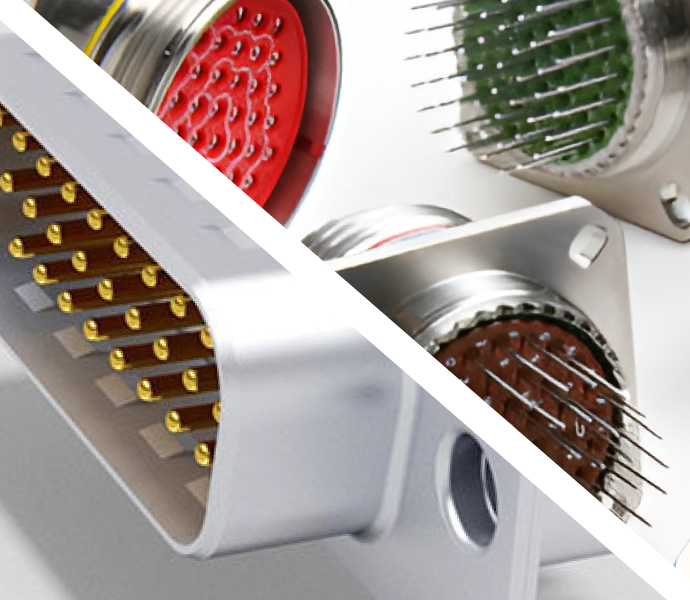
The world of industrial connectors can get intricate, specifically rectangular connectors versus circular connectors. The choices in form factor, which relates to a computing device’s size, configuration, or physical arrangement, are pivotal and influence the functionality and adaptability of these essential components. Connectors, comprising mated pairs known as plugs and receptacles, house conductive metal contacts in dielectric insulators, protected by enclosures against environmental threats. The overarching design philosophy of connectors revolves around two primary shapes: circular and rectangular, each tailored for specific applications.
The Evolution of Connector Shapes
Circular Connectors: A Military Heritage
Circular connectors were developed in the 1930s for the rigorous demands of aeronautical and tactical service applications. Embraced by the U.S. Department of Defense, these connectors were often denoted as “Military Standard” or “Mil-Spec” and proved their mettle in extreme conditions. Today, their versatility extends beyond military use, finding applications in various industrial settings.
These connectors are characterized by their threaded mating process, securing the plug and receptacle in place. This design ensures a robust connection capable of withstanding harsh environments.
Rectangular Connectors: A Response to Circular Prowess
In 1956, Wilhelm Harting introduced rectangular connectors as a direct response to circular Mil-Spec connectors. Offering comparable reliability in challenging environments, rectangular connectors feature a design allowing proximity installation. They typically employ levers or internal locking mechanisms for secure connections.
Why Pin Count Matters
Small Pin Count Favors Circular
The number of pins needed will significantly influence connector size. Circular connectors excel in scenarios with a low pin count (3-5), offering a compact design. As the pin count increases, these connectors expand in radius, becoming larger in all dimensions.
Large Pin Count Prefers Rectangular
Low pin count rectangular connectors are generally larger than their circular counterparts. However, rectangular connectors take the lead beyond five pins because their shape can be extended in a single direction.
Circular for Single-Use Low-Power, Rectangular for High-Power or Multi-Use
Choosing between circular and rectangular connectors depends on the application’s power and functionality requirements. Circular connectors shine in scenarios where each connection point serves a single low-power function and connects to different peripheral devices. For applications demanding higher power or integrating power, signal, and data in one connection point, rectangular connectors emerge as the optimal choice. Modular rectangular connectors enable the combination of diverse functionalities using off-the-shelf modules.
Is a circular or rectangular connector better for your electrical project?
Choosing between circular and rectangular connectors is pivotal. Circular connectors excel in harsh environments, offering compact and durable connections ideal for aerospace and military uses. Meanwhile, rectangular connectors fit best in data and telecom sectors, where easy access and space efficiency are key priorities.
Specific Environments Demand Specific Shapes
Connector shape becomes a critical consideration when the environment poses unique challenges. In industries like food and beverage processing, where washdown environments demand components resistant to high-pressure hoses (IP69K rating), circular connectors prove invaluable. The absence of angles in these connectors prevents food particles from getting trapped, ensuring hygiene and compliance.
Rectangular Connectors Prevail When Panel Density Matters
Panel density, referring to the proximity of connection points, becomes crucial in certain applications. If an application requires numerous connections in a confined space, choosing connectors with high panel density becomes paramount. While circular connectors may be smaller, the space needed for manual twisting during installation can limit their close placement. Rectangular connectors are equipped with double latches, facilitating side-by-side arrangement on panels, and maximizing connections within a given space.
Choosing the Right Connectors
The choice between circular and rectangular connectors transcends mere physical form. It involves meticulously assessing the application’s requirements, considering factors such as pin count, power needs, environmental conditions, and panel density. Engineers navigating this complex landscape must weigh these design philosophies to unlock seamless and efficient connectivity tailored to their specific use cases. As technology advances, the evolution of connectors continues, ensuring that these critical components remain at the forefront of industrial innovation.
Key Takeaways:
The Air Electro Connection
Air Electro (AEI) is a family-owned, veteran-founded organization with a rich legacy spanning over 70 years. Since its establishment in 1952, AEI has offered a comprehensive range of products and services to diverse industries, including Civil Aviation, Aerospace, Defense, and more.
With a commitment to excellence, AEI not only provides an extensive inventory of electrical connectors, contacts, and backshells but also excels in manufacturing custom solutions, showcasing Swiss precision and cutting-edge automation. As we delve into the intricate world of connectors, it becomes evident that the choice between circular and rectangular connectors is a nuanced decision, shaped by diverse factors.
Choose Air Electro for a seamless and reliable connection that stands the test of time. Start today.





